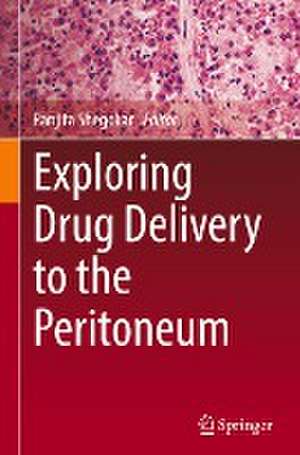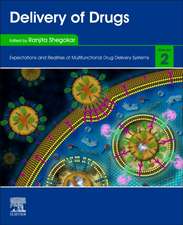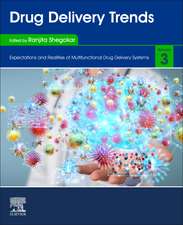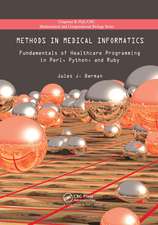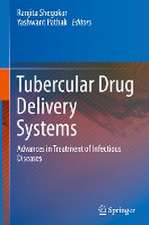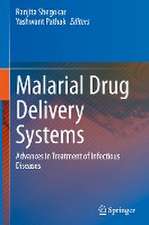Exploring Drug Delivery to the Peritoneum
Editat de Ranjita Shegokaren Limba Engleză Hardback – 30 noi 2023
There are two main challenges one posed by IP cavity where the residence time of a small molecular weight drug (<20 kDa) is not sufficiently long to maintain therapeutic effect. This leads to frequent or continuous dosing. Another challenge is device-related or catheter-related problems, such as catheter obstruction, increased risk of infection, and bowel complications. Overall literature shows that the IP site is satisfactorily explored by clinicians but in terms of drug delivery not that much. One can see a clear-cut gap of expertise exchange between the two fields and guidelines from regulatory lawmakers on new medications.
In summary, challenges like delivery to IP cavity, tumor or organ-specific targeting, efficient tissue penetration, optimal cellular uptake and intracellular residence of a drug, biocompatibility, toxicity, etc can be easily solved by smartly designing functional drug delivery systems (both nano and micro). Nanotechnologies have always fascinated humans for several decades and are now widely explored in the biomedical field. Diverse types of nanoparticles are being explored around the world, some examples include biodegradable nanoparticles, green nanoparticles, polymeric nanoparticles, lipid nanoparticles, metal nanoparticles, graphene, carbon nanotubes, and several others. Now a day's nanoparticles are gaining interest for drug targeting of chemotherapeutic drugs, immunotherapy, and gene delivery. Whereas microparticles can be explored for delayed drug delivery to the peritoneal cavity due to relatively slow removal from IP fluid. Hydrogels or other adhesive drug delivery may help to enhance peritoneal adhesions; thereby maintaining the balance between benefit and risk. Overall, drug delivery systems are key in IP targeting. That means drug delivery specialist and clinician needs to be connected to get the best out of this route of drug administration.
The present book is a link between pharmaceutical scientists (drug formulators), clinicians, toxicologists, and regulatory experts. This book also provides a new perspective to researchers to divert or guide their research in an optimal way. Exploring Drug Delivery to the Peritoneum serves as a platform for upcoming technologies especially in the medical devices sector to face up and show potential in delivering drugs. It is a chance for commercial partners like insurance companies and the pharma industry to explore this direction.
Preț: 1002.94 lei
Preț vechi: 1223.09 lei
-18% Nou
Puncte Express: 1504
Preț estimativ în valută:
191.92€ • 205.22$ • 160.01£
191.92€ • 205.22$ • 160.01£
Carte tipărită la comandă
Livrare economică 17 aprilie-01 mai
Preluare comenzi: 021 569.72.76
Specificații
ISBN-13: 9783031316937
ISBN-10: 3031316932
Pagini: 242
Ilustrații: X, 242 p. 40 illus., 35 illus. in color.
Dimensiuni: 155 x 235 mm
Greutate: 0.53 kg
Ediția:1st ed. 2023
Editura: Springer International Publishing
Colecția Springer
Locul publicării:Cham, Switzerland
ISBN-10: 3031316932
Pagini: 242
Ilustrații: X, 242 p. 40 illus., 35 illus. in color.
Dimensiuni: 155 x 235 mm
Greutate: 0.53 kg
Ediția:1st ed. 2023
Editura: Springer International Publishing
Colecția Springer
Locul publicării:Cham, Switzerland
Cuprins
Chapter 1: Peritoneal Organ-Anatomical and Physiological Considerations
Chapter 2: drug delivery platforms for intra-peritoneal delivery focusing primarily on need, delivery systems, clinical progress, market and regulatory aspects
Chapter 3: Liposomes and Lipid Nanoparticles as Peritoneal Drug Delivery Systems
Chapter 4: Nano and micro/medicines for intraperitoneal therapy in ovarian cancer: critical overview and focus on pharmaceutical manufacturing under cGMP
Chapter 5: Pressurized Intraperitoneal Aerosolized Chemotherapy (PIPAC): Promising Strides from India
Chapter 6: HIPEC: Concept and Fundamentals in Colorectal Cáncer Peritoneal Mestatasis Treatment
Chapter 7: Peritoneal Implants and Drug Delivery
Chapter 8: Importance of Computational Models in Development of Intrapertitoneal Administration based Drug Delivery Systems for Solid Tumors
Chapter 9: Drug Delivery Systems for peritonium : current status and Future perspectives
Chapter 10: Exploring the Intraperitoneal Route in a New Way for Preclinical Testing
Chapter 2: drug delivery platforms for intra-peritoneal delivery focusing primarily on need, delivery systems, clinical progress, market and regulatory aspects
Chapter 3: Liposomes and Lipid Nanoparticles as Peritoneal Drug Delivery Systems
Chapter 4: Nano and micro/medicines for intraperitoneal therapy in ovarian cancer: critical overview and focus on pharmaceutical manufacturing under cGMP
Chapter 5: Pressurized Intraperitoneal Aerosolized Chemotherapy (PIPAC): Promising Strides from India
Chapter 6: HIPEC: Concept and Fundamentals in Colorectal Cáncer Peritoneal Mestatasis Treatment
Chapter 7: Peritoneal Implants and Drug Delivery
Chapter 8: Importance of Computational Models in Development of Intrapertitoneal Administration based Drug Delivery Systems for Solid Tumors
Chapter 9: Drug Delivery Systems for peritonium : current status and Future perspectives
Chapter 10: Exploring the Intraperitoneal Route in a New Way for Preclinical Testing
Notă biografică
Ranjita Shegokar holds a Ph.D. degree in Pharmaceutical Technology from the SNDT University, India, and has been a postdoctoral researcher in the Department of Pharmaceutics, Biopharmaceutics and NutriCosmetics at the Free University of Berlin, Germany. For the last many years, she has been working with various multinational pharmaceutical companies in technical/R&D leadership roles. Currently, she serves as a Chief Scientific Officer (CSO) at Capnopharm GmbH, Germany. She has authored several research articles, book chapters, and presented her research at numerous national/international conferences. She has filed multiple patent applications in the area of drug delivery and targeting. Besides that, she has edited several trending books in the area of pharmaceutical nanotechnology and drug delivery aspects. For her research, she has received numerous prestigious national and international awards among them include recently received the prestigious German Innovation Award 2022. Her areas of interest include polymeric nanoparticles, nanocrystals, lipid nanoparticles (SLNs/NLCs), nanoemulsions, cancer drug targeting, and the role of excipients in delivery systems (www.ranjitas.com).
Textul de pe ultima copertă
The Peritoneal cavity (PC) is the key metastatic site for intra-abdominal malignancies (e.g., GI tract and rectal cancer). PC sites can be used to target several other diseases where lymphatic drug delivery is desired without dumping large amounts of the drug. Until recently, it was thought that treatment with curative intent was impossible but that was challenged by the introduction of cytoreductive surgery (CRS), heated intraperitoneal chemotherapy (HIPEC), and PIPAC (pressurized intraperitoneal aerosol chemotherapy). Recently, a growing number of preclinical and clinical studies advocate intraperitoneal (IP) chemotherapy as an alternative post-operative therapy for cancer. Although their effectiveness has been proven both experimentally and clinically, there is still little understanding of the role of drug delivery systems in targeting drugs in the intraperitoneal (IP) cavity. There are two main challenges posed to such therapies 1) the complexity of IP cavity and 2) the drug transport dynamics e.g., the residence time of small molecular weight drugs, the fate of delivery systems (both nano and micro), etc. The present book is a link between pharmaceutical scientists (drug formulators), clinicians, and toxicologists. This book also provides a new perspective to researchers to divert or guide their research in an optimal way. Exploring Drug Delivery to the Peritoneum serves as a platform for upcoming technologies especially in the medical devices sector to face up and show potential in delivering drugs to IP cavity. It is a chance for commercial partners like insurance companies and the pharma industry to explore the old administration route in a new way.
Caracteristici
Unique compilation of research-clinical-toxicity-regulatory data
Unique collection of DDS (drug delivery systems) explored till now
Serves one stop information source for all stages of drug targeting research to peritoneum
Unique collection of DDS (drug delivery systems) explored till now
Serves one stop information source for all stages of drug targeting research to peritoneum
